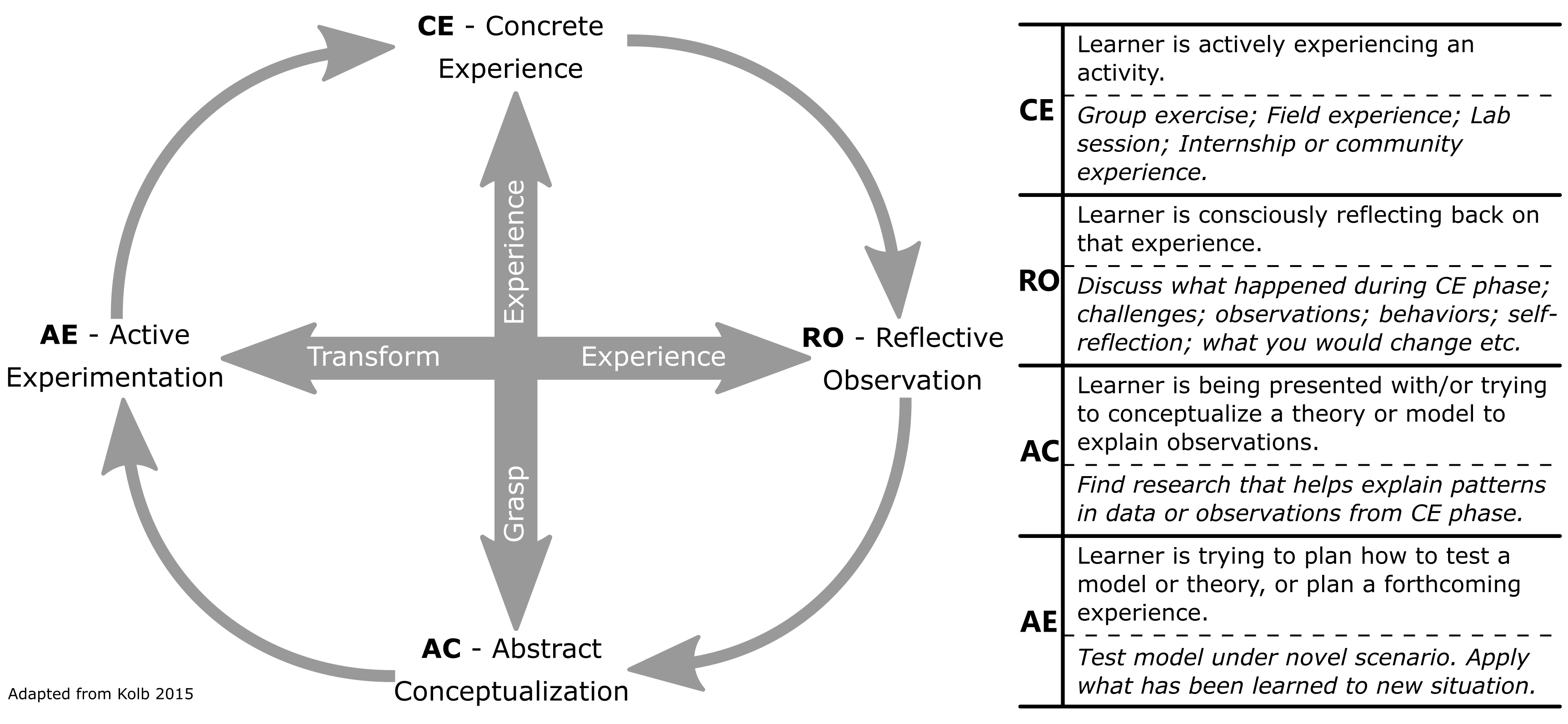How to implement
All of the following information (and more) can be found in our TIDES Experiental Learning Guide.
Where do I begin?
Implementing experiential learning (EL) into your classroom may seem like a challenging, overly time-consuming, and perhaps too expensive of a task. For deeply immersive and high-impact EL, this can certainly be the case. However, EL practices can be broadly implemented into any class by designing instructional activities that are built off of EL theory. It helps to know a bit of background information on EL before jumping in and doing it. Below is a brief introduction to a widely accepted and cited EL theory, and a brief set of guiding questions to help you start thinking about how to infuse EL into your teaching.
What is experiential learning theory?
There are several experiential learning (EL) theories, however David Kolb's model is probably the most widely accepted model for EL. The infographic shown below is adapted from the most recent edition of this model (Kolb 2015).

The foundation for Kolb’s Experiential Learning Cycle is that knowledge results from the combination of grasping and transforming experience. Grasping experience (vertical axis) refers to the process of taking in information, and transforming experience (horizontal axis) is how individuals interpret and act on that information. This process can be illustrated by an idealized and simplified cycle (or spiral) where a learner “touches all the bases”—experiencing (CE), reflecting (RO), thinking (AC), and acting (AE)—which should be tailored to the context and content of the learning situation. We often do “grasping” well in our classes, but tend to lack on the “transforming” of information. Learning happens through the experience itself, AND the process of learning from that experience and applying to novel situations (Kolb 2015).
What are some common forms of experiential learning?
Experiential learning (EL) comes in many flavors. Below is a short list a few a ways in which EL is typically carried out in college classrooms. Use this list as a starting point, but feel free to be innovative.
Active learning involves getting students to do anything other than only listening and taking notes that engages them in the class material. EL is by definition active; however, not ALL active learning counts as EL. To make active learning more experiential, be sure to have your studens think about (reflect) on what they are doing. TIDES has an active learning page that you can consult for ideas.
Problem-based and Inquiry based learning involve having students find solutions to authentic problems through in-depth investigation, where instructors tyipcally provide the problems for problem-based learning, and students define problems on their own for inquiry-based learning.
Project-based learning involves learning by carrying out a project to completion. Project-based learning tends to focus heavily on skill building (eg, problem solving, communication, collaboration, self-directed learning) rather than strictly on the broadening of discipline-based content knowledge.
Service-learning and Place-based learning entails learning through service in the community or placement off campus, both of which are relevant to the course material. These types of learning most readily fit the EL cycle outlined above.
How can I do experiential learning in my class?
Below are a set of guiding prompts to help you prepare EL activities that you might include in your class.
Describe a new or existing activity or experience from your class that you would like to make experiential.
First think about all of the instructional activities that you already have your students do. This may provide a list of potential entrypoints for introducing EL into your class. Alternatively, there may be instructional activities or assignments that you would like to try. Once you have identified one, describe it.
What is the learning objective(s) of this activity?
Outline what you would like your students to be able to do once they have completed this activity. Be sure to use measurable action verbs when listing out the learning objectives - this will help you identify the goals of the activity, and how you intend to assess whether your students have achieved those goals.
List potential problems that students would need to solve during this activity.
By knowing the intermediate problems that students will need to solve, this may help you decide on activities that would facilitate them working towards their final goals.
List some opportunities for primary experiences. What are the hands-on activities students can do?
Here, you want to outline all of the possible ways that students can do the "hands-on" pieces of this activity. These are the experiences that will cover the "grasping" knowledge axis, or the CE and AC experiences from the figure above.
List some opportunities for secondary experiences. How will students think about what they done?
Here, outline some ways that you can have students reflect on their work, and prepare to apply what they have learned to novel situations. These are the experiences that will cover the "transforming" knowledge axis, or the RO and AE experiences from the figure above.
Reflection is a critical component of EL. There are many different ways to faciliate reflection in your class, but here are a few ideas: Group discussions followed by a class share-out; Written pieces; Video, or audio recordings; Blog or vlog posts; Self-evaluations. You can structure reflection activities to be included as few or as many times as fits your course.
Now that I have my ideas together, what next?
Use a combination of Kolb's EL cycle, and the following EL guide to help you think about how you might structure your EL activity into your class. Remember that EL can be done in as little time as a single class to a whole semester (or longer). So provide the appropriate amount of time for you and your students to complete the EL activity you are planning.
TIDES Experiential Learning Guide















